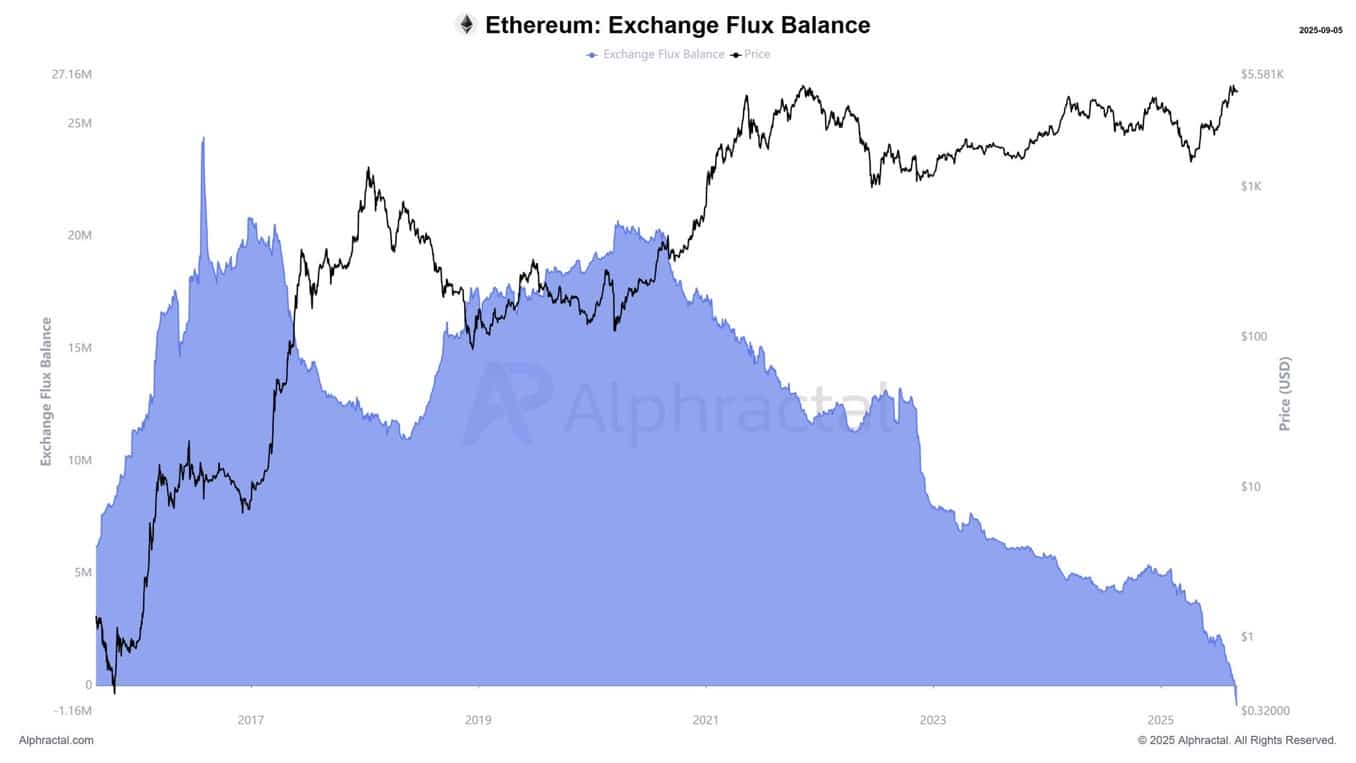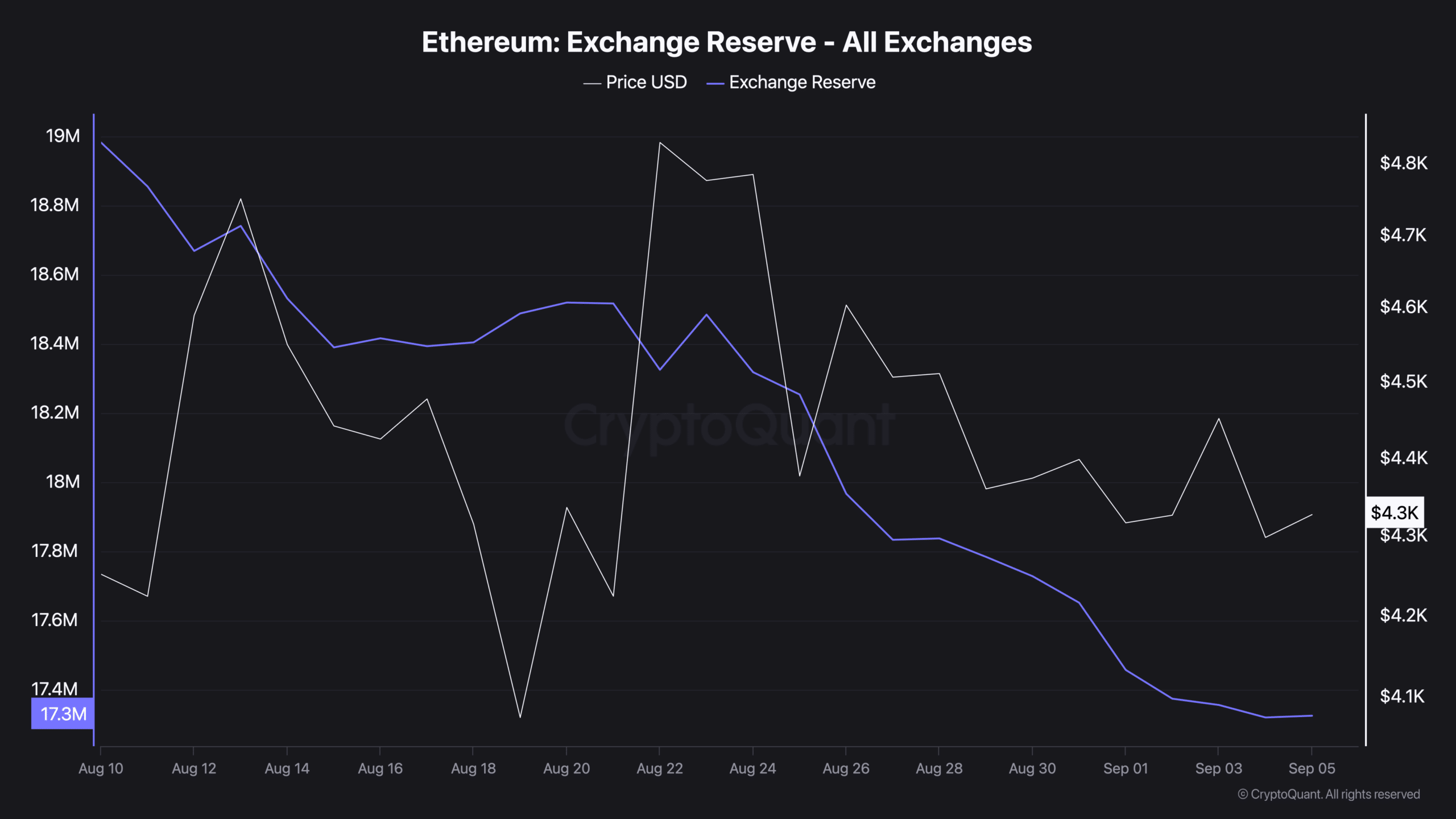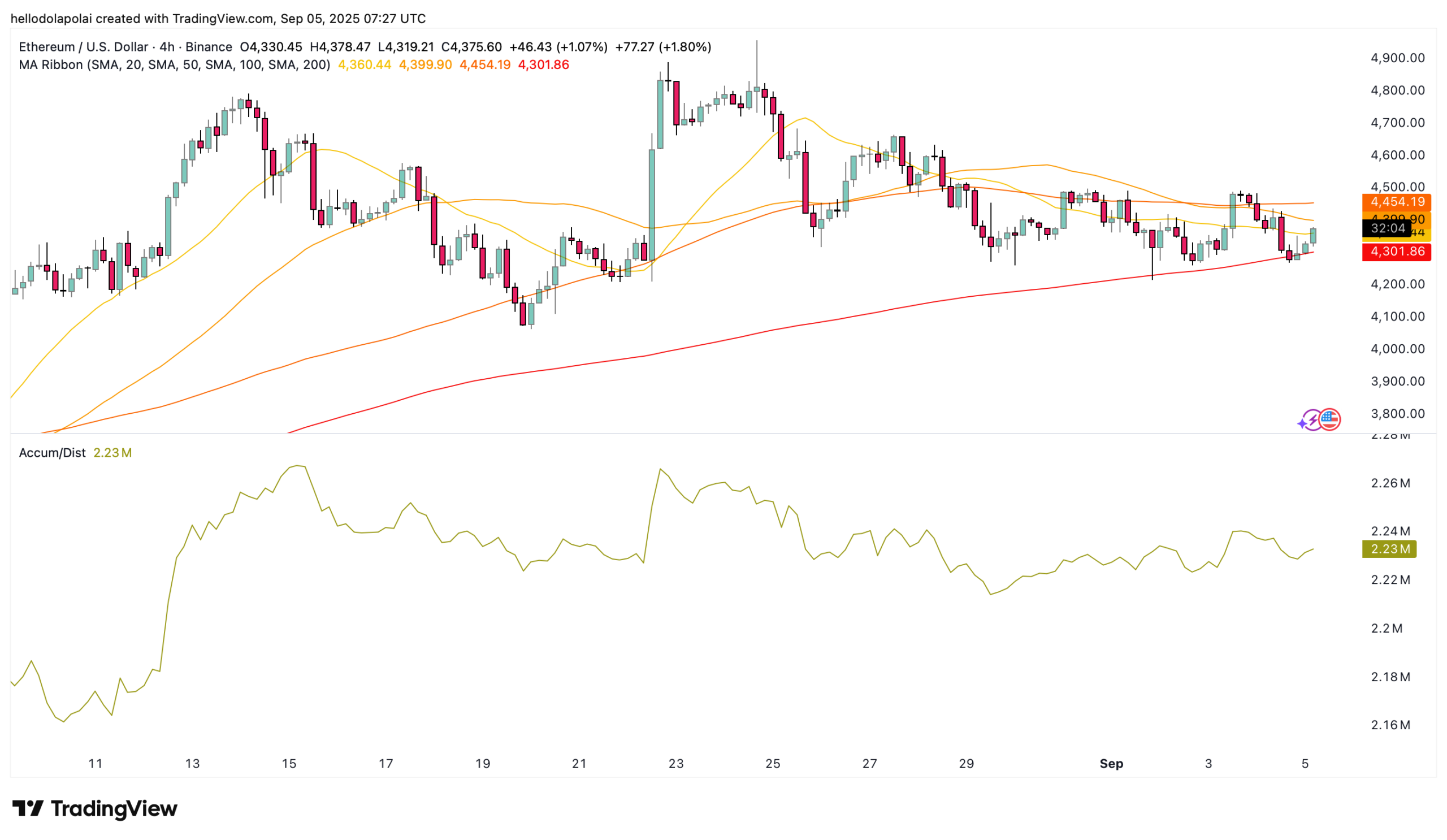| COINOTAG recommends • Exchange signup |
| 💹 Trade with pro tools |
| Fast execution, robust charts, clean risk controls. |
| 👉 Open account → |
| COINOTAG recommends • Exchange signup |
| 🚀 Smooth orders, clear control |
| Advanced order types and market depth in one view. |
| 👉 Create account → |
| COINOTAG recommends • Exchange signup |
| 📈 Clarity in volatile markets |
| Plan entries & exits, manage positions with discipline. |
| 👉 Sign up → |
| COINOTAG recommends • Exchange signup |
| ⚡ Speed, depth, reliability |
| Execute confidently when timing matters. |
| 👉 Open account → |
| COINOTAG recommends • Exchange signup |
| 🧭 A focused workflow for traders |
| Alerts, watchlists, and a repeatable process. |
| 👉 Get started → |
| COINOTAG recommends • Exchange signup |
| ✅ Data‑driven decisions |
| Focus on process—not noise. |
| 👉 Sign up → |
Ethereum exchange flux shows net outflows and rising ETH accumulation, signaling reduced sell-side pressure and a potential short-term bullish setup for ETH. Netflows and flat exchange reserves suggest investors are moving ETH to private wallets, supporting a tighter supply outlook.
-
Netflows turned negative for the first time; 36,089 ETH moved net out of exchanges in 24h.
-
Exchange reserves remained ~17.3 million ETH, indicating limited immediate selling supply.
-
Accumulation climbed to 2.23 million ETH, with mid-term SMAs showing bullish momentum (100-day above 200-day).
Meta description: Ethereum exchange flux shows net outflows and rising ETH accumulation—discover what this means for ETH price action and next steps. Read Coinotag analysis now.
What is Ethereum exchange flux and does it signal an ETH bull run?
Ethereum exchange flux is a netflows metric that measures cumulative ETH moving in and out of exchanges. A negative flux indicates more withdrawals than deposits, which often reduces available sell-side supply and can support bullish price moves in the short term.
| COINOTAG recommends • Professional traders group |
| 💎 Join a professional trading community |
| Work with senior traders, research‑backed setups, and risk‑first frameworks. |
| 👉 Join the group → |
| COINOTAG recommends • Professional traders group |
| 📊 Transparent performance, real process |
| Spot strategies with documented months of triple‑digit runs during strong trends; futures plans use defined R:R and sizing. |
| 👉 Get access → |
| COINOTAG recommends • Professional traders group |
| 🧭 Research → Plan → Execute |
| Daily levels, watchlists, and post‑trade reviews to build consistency. |
| 👉 Join now → |
| COINOTAG recommends • Professional traders group |
| 🛡️ Risk comes first |
| Sizing methods, invalidation rules, and R‑multiples baked into every plan. |
| 👉 Start today → |
| COINOTAG recommends • Professional traders group |
| 🧠 Learn the “why” behind each trade |
| Live breakdowns, playbooks, and framework‑first education. |
| 👉 Join the group → |
| COINOTAG recommends • Professional traders group |
| 🚀 Insider • APEX • INNER CIRCLE |
| Choose the depth you need—tools, coaching, and member rooms. |
| 👉 Explore tiers → |
How did recent netflows and reserves behave, and what does that mean?
Exchange Netflows data showed a 24-hour net outflow of 36,089 ETH, while broader Exchange Flux Balance also recorded its first-ever negative reading. These readings imply investors are withdrawing ETH to private custody or staking, tightening liquid supply.
Exchange reserves tracked at the time of writing were ~17.3 million ETH. Flat reserves with net outflows typically indicate measured accumulation rather than panic selling, increasing odds of a supply squeeze if outflows persist.
| COINOTAG recommends • Exchange signup |
| 📈 Clear interface, precise orders |
| Sharp entries & exits with actionable alerts. |
| 👉 Create free account → |
| COINOTAG recommends • Exchange signup |
| 🧠 Smarter tools. Better decisions. |
| Depth analytics and risk features in one view. |
| 👉 Sign up → |
| COINOTAG recommends • Exchange signup |
| 🎯 Take control of entries & exits |
| Set alerts, define stops, execute consistently. |
| 👉 Open account → |
| COINOTAG recommends • Exchange signup |
| 🛠️ From idea to execution |
| Turn setups into plans with practical order types. |
| 👉 Join now → |
| COINOTAG recommends • Exchange signup |
| 📋 Trade your plan |
| Watchlists and routing that support focus. |
| 👉 Get started → |
| COINOTAG recommends • Exchange signup |
| 📊 Precision without the noise |
| Data‑first workflows for active traders. |
| 👉 Sign up → |

Source: Alphractal (chart)
| COINOTAG recommends • Traders club |
| ⚡ Futures with discipline |
| Defined R:R, pre‑set invalidation, execution checklists. |
| 👉 Join the club → |
| COINOTAG recommends • Traders club |
| 🎯 Spot strategies that compound |
| Momentum & accumulation frameworks managed with clear risk. |
| 👉 Get access → |
| COINOTAG recommends • Traders club |
| 🏛️ APEX tier for serious traders |
| Deep dives, analyst Q&A, and accountability sprints. |
| 👉 Explore APEX → |
| COINOTAG recommends • Traders club |
| 📈 Real‑time market structure |
| Key levels, liquidity zones, and actionable context. |
| 👉 Join now → |
| COINOTAG recommends • Traders club |
| 🔔 Smart alerts, not noise |
| Context‑rich notifications tied to plans and risk—never hype. |
| 👉 Get access → |
| COINOTAG recommends • Traders club |
| 🤝 Peer review & coaching |
| Hands‑on feedback that sharpens execution and risk control. |
| 👉 Join the club → |
How reliable are Netflows and Exchange Reserves as indicators?
Netflows and exchange reserves are on-chain supply metrics widely used to gauge potential selling pressure. CryptoQuant and other on-chain platforms provide exchange-level snapshots that, when combined with accumulation indicators, create a clearer picture of market intent.
Coinotag analysis: “A sudden, sustained shift to negative netflows accompanied by rising accumulation typically precedes tighter markets and can accelerate rallies if demand remains steady.”
What do accumulation metrics show now?
The Accumulation/Distribution indicator moved into positive territory on the 1-day chart, with total accumulation near 2.23 million ETH. This points to more buying than selling on recent sessions and supports bullish price bias.
Technical context: the 100-day SMA remained above the 200-day SMA—an established mid-term bullish signal—while shorter SMAs (20/50-day) staying above the 200-day SMA strengthen the momentum case.
| COINOTAG recommends • Exchange signup |
| 📈 Clear control for futures |
| Sizing, stops, and scenario planning tools. |
| 👉 Open futures account → |
| COINOTAG recommends • Exchange signup |
| 🧩 Structure your futures trades |
| Define entries & exits with advanced orders. |
| 👉 Sign up → |
| COINOTAG recommends • Exchange signup |
| 🛡️ Control volatility |
| Automate alerts and manage positions with discipline. |
| 👉 Get started → |
| COINOTAG recommends • Exchange signup |
| ⚙️ Execution you can rely on |
| Fast routing and meaningful depth insights. |
| 👉 Create account → |
| COINOTAG recommends • Exchange signup |
| 📒 Plan. Execute. Review. |
| Frameworks for consistent decision‑making. |
| 👉 Join now → |
| COINOTAG recommends • Exchange signup |
| 🧩 Choose clarity over complexity |
| Actionable, pro‑grade tools—no fluff. |
| 👉 Open account → |

Source: CryptoQuant (reserve series)
| COINOTAG recommends • Members‑only research |
| 📌 Curated setups, clearly explained |
| Entry, invalidation, targets, and R:R defined before execution. |
| 👉 Get access → |
| COINOTAG recommends • Members‑only research |
| 🧠 Data‑led decision making |
| Technical + flow + context synthesized into actionable plans. |
| 👉 Join now → |
| COINOTAG recommends • Members‑only research |
| 🧱 Consistency over hype |
| Repeatable rules, realistic expectations, and a calmer mindset. |
| 👉 Get access → |
| COINOTAG recommends • Members‑only research |
| 🕒 Patience is an edge |
| Wait for confirmation and manage risk with checklists. |
| 👉 Join now → |
| COINOTAG recommends • Members‑only research |
| 💼 Professional mentorship |
| Guidance from seasoned traders and structured feedback loops. |
| 👉 Get access → |
| COINOTAG recommends • Members‑only research |
| 🧮 Track • Review • Improve |
| Documented PnL tracking and post‑mortems to accelerate learning. |
| 👉 Join now → |
When could these indicators translate into a stronger ETH rally?
Indicators typically confirm a durable rally when on-chain outflows persist and shorter-term SMAs confirm crossover momentum. If negative netflows continue and exchange reserves trend lower, available supply for immediate sale would shrink and create a favorable backdrop for price appreciation.
How should traders and investors interpret this?
- Traders: watch netflows and short SMA crossovers for entry confirmation and manage risk with defined stop levels.
- Investors: accumulation and lower liquid supply support medium-term positioning; consider staggered buys.
- Long-term holders: continued withdrawals to cold wallets or staking reduce circulating sell pressure—monitor staking and withdrawal trends.

| COINOTAG recommends • Exchange signup |
| 🎯 Focus on process over noise |
| Plan trades, size positions, execute consistently. |
| 👉 Sign up → |
| COINOTAG recommends • Exchange signup |
| 🛠️ Simplify execution |
| Keep decisions clear with practical controls. |
| 👉 Get started → |
| COINOTAG recommends • Exchange signup |
| 📊 Make data your edge |
| Use depth and alerts to avoid guesswork. |
| 👉 Open account → |
| COINOTAG recommends • Exchange signup |
| 🧭 Be prepared, not reactive |
| Turn setups into rules before you trade. |
| 👉 Create account → |
| COINOTAG recommends • Exchange signup |
| ✍️ Plan first, then act |
| Entries, exits, and reviews that fit your routine. |
| 👉 Join now → |
| COINOTAG recommends • Exchange signup |
| 🧩 Consistency beats intensity |
| Small, repeatable steps win the long run. |
| 👉 Sign up → |
Source: TradingView (price & indicator)
Summary table: Key on-chain metrics
| Metric |
Current reading |
Implication |
| Exchange Netflows (24h) |
−36,089 ETH |
Net outflows reduce immediate sell liquidity |
| Exchange Reserves |
~17.3 million ETH |
Flat but not rising—limited additional sell supply |
| Accumulation (A/D) |
2.23 million ETH |
More buyers than sellers; bullish bias |
| SMA structure |
100-day > 200-day |
Mid-term momentum skewed to bulls |
Frequently Asked Questions
Can negative exchange flux alone trigger an ETH rally?
Negative exchange flux reduces available sell-side supply, which can support rallies if demand holds. However, price moves usually require a confluence of factors—net outflows, rising accumulation, and positive technical momentum.
| COINOTAG recommends • Premium trading community |
| 🏛️ WAGMI CAPITAL — Premium Trading Community |
| Strategic insights, exclusive opportunities, professional support. |
| 👉 Join WAGMI CAPITAL → |
| COINOTAG recommends • Premium trading community |
| 💬 Inner Circle access |
| See members share real‑time PnL and execution notes in chat. |
| 👉 Apply for Inner Circle → |
| COINOTAG recommends • Premium trading community |
| 🧩 Turn theses into trades |
| Reusable templates for entries, risk, and review—end to end. |
| 👉 Join the club → |
| COINOTAG recommends • Premium trading community |
| 💡 Long‑term mindset |
| Patience and discipline over noise; a process that compounds. |
| 👉 Get started → |
| COINOTAG recommends • Premium trading community |
| 📚 Education + execution |
| Courses, playbooks, and live market walkthroughs—learn by doing. |
| 👉 Get access → |
| COINOTAG recommends • Premium trading community |
| 🔒 Members‑only research drops |
| Curated analyses and private briefings—quality over quantity. |
| 👉 Join WAGMI CAPITAL → |
How long should netflows stay negative to matter?
Sustained negative netflows over several days to weeks generally have a more meaningful impact than a single-day outflow, as persistent withdrawals steadily remove liquid supply from markets.
Key Takeaways
- Net outflows matter: Negative exchange flux and a 24h net outflow of 36,089 ETH point to reduced immediate sell liquidity.
- Accumulation is rising: A/D at ~2.23 million ETH signals more buyers than sellers and supports bullish bias.
- Watch reserves and SMAs: Flat exchange reserves (~17.3M ETH) and SMA structure favor bulls—monitor continuation for confirmation.
Conclusion
Ethereum exchange flux and accumulation metrics currently indicate a market leaning toward bulls. While single-day readings require confirmation, persistent negative netflows combined with rising accumulation and favorable SMA structure increase the probability of a near-term ETH rally. Monitor netflow trends and reserve movement for confirmation; Coinotag will continue to track these signals.
| COINOTAG recommends • Exchange signup |
| 🧱 Execute with discipline |
| Watchlists, alerts, and flexible order control. |
| 👉 Sign up → |
| COINOTAG recommends • Exchange signup |
| 🧩 Keep your strategy simple |
| Clear rules and repeatable steps. |
| 👉 Open account → |
| COINOTAG recommends • Exchange signup |
| 🧠 Stay objective |
| Let data—not emotion—drive actions. |
| 👉 Get started → |
| COINOTAG recommends • Exchange signup |
| ⏱️ Trade when it makes sense |
| Your plan sets the timing—not the feed. |
| 👉 Join now → |
| COINOTAG recommends • Exchange signup |
| 🌿 A calm plan for busy markets |
| Set size and stops first, then execute. |
| 👉 Create account → |
| COINOTAG recommends • Exchange signup |
| 🧱 Your framework. Your rules. |
| Design entries/exits that fit your routine. |
| 👉 Sign up → |
| COINOTAG recommends • Members‑only research |
| 📌 Curated setups, clearly explained |
| Entry, invalidation, targets, and R:R defined before execution. |
| 👉 Get access → |
| COINOTAG recommends • Members‑only research |
| 🧠 Data‑led decision making |
| Technical + flow + context synthesized into actionable plans. |
| 👉 Join now → |
| COINOTAG recommends • Members‑only research |
| 🧱 Consistency over hype |
| Repeatable rules, realistic expectations, and a calmer mindset. |
| 👉 Get access → |
| COINOTAG recommends • Members‑only research |
| 🕒 Patience is an edge |
| Wait for confirmation and manage risk with checklists. |
| 👉 Join now → |
| COINOTAG recommends • Members‑only research |
| 💼 Professional mentorship |
| Guidance from seasoned traders and structured feedback loops. |
| 👉 Get access → |
| COINOTAG recommends • Members‑only research |
| 🧮 Track • Review • Improve |
| Documented PnL tracking and post‑mortems to accelerate learning. |
| 👉 Join now → |










